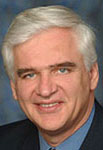Directors & principle investigators
Co-Directors

Prof. Fritz B. Prinz Professor and Chairman of Mechanical Engineering
|
 Prof. Stacey BentProfessor of Chemical Engineering
|
Executive Director
Consulting Prof. Turgut M. Gür

Department of Materials Science and Engineering, Stanford
University
B.S. and M.S. in Chemical Engineering, Middle East Technical
University, Turkey
Ph.D. in Materials Science and Engineering, Stanford
University - 1976
turgut(at)stanford.edu
Turgut Gür has the responsibility for day-to-day operation and management of CNEEC and its programs. He has previously served as the Technical Director for the NSF-funded Center for Materials Research on campus for more than a decade, and subsequently served as the founding Technical Director for Geballe Laboratory for Advanced Materials for several years. He provides expertise in solid state electrochemistry and electrocatalysis, fuel cells, membranes and sensors, defect equilibria and ion transport in solids, synthesis and characterization, and hydrocarbon conversion.
Principal Investigators:
- Prof. Mark Brongersma, Department of Materials Science and Engineering,
Stanford University,
markb29(at)stanford.edu
http://brongersma.stanford.edu/main/ - Prof. Bruce Clemens, Department of Materials Science and Engineering,
Stanford University,
bmc(at)stanford.edu
http://www.stanford.edu/group/clemensgroup/ - Prof. Yi Cui, Department of Materials Science and Engineering, Stanford
University,
yicui(at)stanford.edu
http://www.stanford.edu/group/cui_group/yicui.html - Prof. Shanhui Fan, Department of Electrical Engineering, Stanford University,
Shanhui(at)stanford.edu
http://www.stanford.edu/group/fan/ - Prof. David Goldhaber-Gordon, Department of Physics, Stanford
University,
goldhaber-gordon(at)stanford.edu
http://www.stanford.edu/group/GGG/. - Prof. Arthur Grossman, Carnegie Institution for Plant
Biology,
arthurg(at)stanford.edu
http://carnegiedpb.stanford.edu/grossman-lab - Prof. Thomas Jaramillo, Department of Chemical Engineering, Stanford
University,
jaramillo(at)stanford.edu
http://cheme.stanford.edu/faculty/layout.php?sunetid=jaramillo - Prof. Karsten W. Jacobsen, Department of Physics, Technical University of Denmark,
kwj(at)fysik.dtu.dk
http://www.camd.dtu.dk - Prof. Jens NÝrskov, Department of Chemical Engineering, Stanford
University,
norskov(at)stanford.edu
http://soe.stanford.edu/research/layout.php?sunetid=norskov - Prof. Robert Sinclair, Department of Materials Science and Engineering,
Stanford University,
bobsinc(at)stanford.edu
http://soe.stanford.edu/research/layout.php?sunetid=bobsinc - Prof. Xiaolin Zheng, Department of Mechanical Engineering, Stanford
University,
xlzheng(at)stanford.edu
http://www.stanford.edu/group/zheng/
Center on Nanostructuring for Efficient Energy Conversion is an Energy Frontier Research Center funded by the U.S. Department of Energy, Office of Science and Office of Basic Energy Sciences
